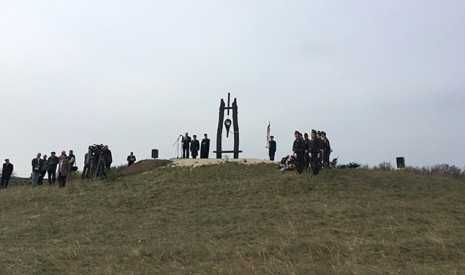Strategic Airlift Capability Pays Tribute to Fallen Hungarian Soldiers
Szöveg: honvedelem.hu / sacprogram.org | 2017. április 27. 9:00On Wednesday 12 April, the Strategic Airlift Capability (SAC) conducted a local low-level training mission to support the commemoration ceremony for Hungarian soldiers killed in an aircraft accident that occured in Jutaspuszta near Veszprém on that same date in 1941.

Commemoration ceremony and Wreath laying in Jutaspuszta. Photo: HAW
The 1941 mishap aircraft was a Savoia-Marchetti SM.75, a transport aircraft manufactured in Italy. Hungary operated five SM.75s for paratrooper transport. The Paratroopers onboard the lost aircraft were stationed at Pápa Air Base.
With the location of the accident being so close to the SAC program home station in Pápa, that used to be the home station for the Hungarian Paratroopers, and the obvious connection with a transport aircraft involved, it was satisfying and an honor to pay tribute to the lost Hungarian soldiers. In addition to the C-17 fly-by, the SAC was represented at the commemoration ceremony by HAW Vice Commander, Colonel Bjørn Gohn-Hellum and HAW Protocol Officer, Captain Miklós Pelsőci, who laid a wreath in memory of the fallen Hungarian colleagues.
Over the years many things have changed when it comes to transport aircraft, but some things remain the same. The C-17 operated by the SAC program perform similar airdrop missions as the lost SM.75 did. Although there are obvious differences between the two aircraft, there are similarities too. The SM.75 was designed to be able to operate on short runways and secondary airfields, much like the C-17 with its capability for what today is known as Semi-Prepared Runway Operations (SPRO).
The accident in Jutaspuszta killed Airmen and Paratroopers of the Hungarian Defense Forces, and happened just after take-off from the airfield that was situated in Veszprém. Today there is an airdrop zone in the vicinity of where the airfield was located that the SAC program uses for local airdrop training on a regular basis.
About the Strategic Airlift Capability
Strategic Airlift Capability (SAC), established in 2008, is a multinational program that provides its 12 member nations with assured access to military airlift capability by owning and operating three Boeing C-17A Globemaster III long-range cargo aircraft.
SAC is based at the Hungarian Defence Forces (HDF) Pápa Air Base, Hungary.
The SAC Nations are the NATO members Hungary (program host nation), Bulgaria, Estonia, Lithuania, the Netherlands, Norway, Poland, Romania, Slovenia and the United States and NATO Partnership for Peace nations Finland and Sweden. Each participating nation owns a share of the available flight hours of the SAC C-17As to serve the needs of their national defence, NATO, EU or UN commitments and humanitarian relief efforts.
SAC consists of the 12-nation Heavy Airlift Wing (HAW) and the NATO Airlift Management Programme Office (NAM PO). The HAW is the operational unit and the NAM PO, an integral part of the NATO Support and Procurement Agency (NSPA), is the acquisition and sustainment authority of the SAC C-17A weapon system.
NAM PO contracts Boeing via a Foreign Military Sales (FMS) agreement to provide technical support for the SAC C-17A aircraft.